Aged Woman With Sudden Striking and Unfamiliar Oral Lesion
An 89-year-old woman is seen because of a white area on the tongue. She has been hospitalized on a behavioral health unit for 2 weeks; 1 day ago, enoxaparin was begun for a new left leg deep venous thrombosis. Recent antibiotic therapy for a urinary tract infection; candidal vulvitis followed and was treated with topical clotrimazole. Has penicillin allergy.
This article was originally presented as an independent educational activity under the direction of CME LLC. The ability to receive CME credits has expired. The article is now presented here for your reference. CME LLC is no longer responsible for the presentation of the article.
History
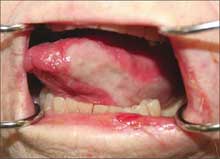
An 89-year-old woman is seen because of a white area on the tongue. She has been hospitalized on a behavioral health unit for 2 weeks; 1 day ago, enoxaparin was begun for a new left leg deep venous thrombosis. Recent antibiotic therapy for a urinary tract infection; candidal vulvitis followed and was treated with topical clotrimazole. Has penicillin allergy.
Physical Examination
Afebrile woman whose mouth hurts. Lucid in discussing symptoms; shows appropriate affect. Local facial swelling. Superficial temporal arteries pulsatile, non-tender, and non-nodular. White area on tongue tender. Unable to remove white material with tongue blade despite vigorous technique.
No regional lymphadenopathy. No skin lesions; preexisting groin mycosis almost completely cleared up. Breathing is easy and quiet; on auscultation air exchange normal, with no crackles or wheezes.
What ’sYour Diagnosis?
Answer: Bizarre White Tongue
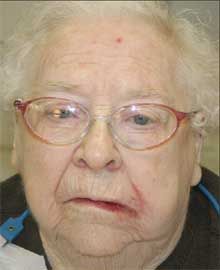
Multiple soft-tissue abnormalities coexist: The tongue shows a large white zone that extends posteriorly well beyond the limit of the remaining lower dentition, so it cannot be any sort of a dental friction lesion akin to the “bite line.” It appears to be some sort of ulceration (which typically appears as a fibrinous membrane surrounded by erythema, though the surface of such debris atop ulcers can usually be removed by wiping). The overlying slough or exudate disguises any breach in the epithelium, and since we can’t remove it and see the breach, many non-dentists would not recognize it as an ulcer; and we can proceed with the differential diagnosis anyway. The area in question extends onto adjacent gingiva-which is only recognized because the broad “bone-white zone,”1 lateral to the most distal (posterior) lower tooth in the image and half-overlain by the lower dental retractor, can’t be either tooth or jaw, and has to be gingival. It also involved some buccal mucosa immediately facing the corresponding part of the tongue. There were no vesicles. The irregular borders faded into adjacent mucosa, and there was no surrounding ring of erythema as one might expect if this were an abscess.
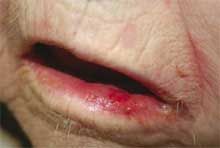
Facial swelling was present (Figure 1) and a marked concomitant maceration of the lip, especially the angle, constituting an angular cheilitis (Figure 2).2
Wide-Ranging Differential Diagnosis
This lesion was a terrible puzzler. One initially thinks about candidal infection, and so we began empiric topical antifungals, confident that this would help treat the angle of the mouth, since angular cheilitis is often at least partly fungal in nature; and started oral clindamycin to cover oral anaerobes, not because this appeared to be a Vincent angina but because superinfection might rapidly kill the frail host. The possibility of sublingual hematoma, sometimes seen with anticoagulation therapy,3 was rapidly rejected as not corresponding to the lesion pattern. Likewise, the idea of a tongue infarction in giant cell arteritis4-7 was discarded based on involvement of non-lingual tissues, and lack of any feature to support a diagnosis of temporal arteritis.
Supportive measures included softening the diet to pureed food, adding around-the-clock analgesia, minimizing inessential orally administered medication, and providing intravenous fluids for hydration, glucose, and electrolyte requirements. Clearly dental consultation was indispensable, the sooner the better.
Tongue swelling was recognized by the dentist after having been missed by the physician: the midline of the tongue appeared to have been pushed rightward by swelling, there was diffuse background mild erythema of the tongue associated with the area in and directly around the ulceration/white patch, and the tongue was taller, ie, increased in vertical dimension compared with normal. The tongue swelling did not suggest potential obstruction of the airway as it would in anaphylaxis or its variants.8
Mucosa Versus Keratinized
The dentist considered trauma-such as tongue biting or insertion of a toothbrush too vigorously-with superimposed candidal infection as a possible cause.
mong other considerations, she thought about whether the problem were confined to oral mucosa alone (inner part of lip, buccal mucosa, ventrolateral tongue), or to keratinized epithelium (dorsum of tongue, gingiva, and outer lip). However, the lesions in this patient included both keratinized and non-keratinized tissues. Aphthous ulcers, which can be extremely debilitating and not only in AIDS,9 are usually confined to mucosa, while oral herpesvirus infection favors the keratinized epithelium. These facts completed the exclusion of herpes and of aphthae.
Checking in with the Experts
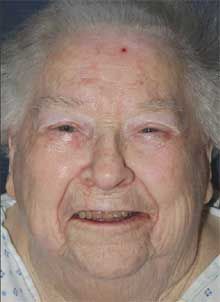
Candidal glossitis as a primary diagnosis was excluded based on the lack of removability of the white material.10 Clinical photographs were dispatched to the oral medicine and oral pathology consultants at University of Connecticut Health Center for an opinion at a distance, since the patient could not be moved. Our colleagues stated that the appearance was not classic for any one condition, but that it suggested to them an oral form of erythema multiforme or other immunological process.11 The patient’s medication list was studied repeatedly for any new medicine that might have triggered such a reaction, and none could be identified. The consultants recommended a course of systemic corticosteroids with extremely close monitoring for adverse effects.
What We Thought it Wasn't
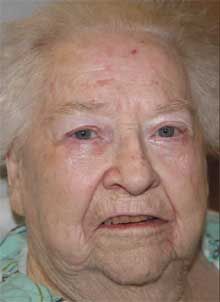
A bacterial swab culture taken from the tongue revealed methicillin-resistant Staphylococcus aureus, and the patient was moved to the medical hospital unit within our building because of her fragility and the need for exceptionally close medical and nursing monitoring and intervention.
There she received intravenous vancomycin, along with continuing the topical antifungals begun earlier, even though nobody felt that the oral lesions represented primary staphylococcal infection; however, one sought to avoid superinfection of an ulcerated zone in this frail patient with recent antibiotic exposure, even believing as we did that the culture reflected mere surface colonization of the ulcer/plaque.
So Were Corticosteroids Used?
In this context, the treating physician deferred systemic corticosteroid treatment. From the shape of the patient’s face one might very well mistakenly infer that high-dose corticosteroid therapy had been given (Figures 3 and 4).

At first, resolution of the tongue was slow (Figure 5), and then all of a sudden the area improved dramatically (Figures 6 and 7), and the patient was able to leave the hospital unit.
We were very happy for her improvement, but intellectually frustrated because though healing is always desired, lacking a diagnostic answer, we don’t know whether any of our interventions, beyond mere support, contributed to the favorable outcome.
White Lesions that Cannot Be Scraped Off
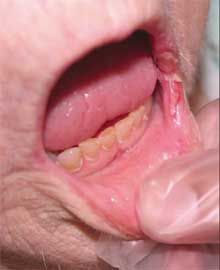
As we considered this case, we reviewed the long list of lessfamiliar causes of persistent white lesions in the mouth. In doing so, we excluded several other possibilities12-14:
•Linea alba consists of a white line on the buccal mucosa located opposite the occlusal surfaces of teeth. It results from local hyperkeratosis caused by frequent cheekbiting and is typically but not always bilateral. Our patient’s lesions were on the wrong surfaces and extended from keratinized onto non-keratinized surfaces.
•Leukoedema: This bilateral diffuse milky white coloring of buccal mucosa cannot be rubbed away, but does disappear when the cheek is pulled taut, as it results from local edema along with thickening of epithelium. Again, the location was wrong. We did not do the pulling test but will be empowered to do so next time!
•Lichen planus, an immunologically mediated mucocutaneous disorder, takes several forms. White lacey lesions appear in several oral epithelia, and while it tends to wax and wane over weeks to months, the lesion morphology, distribution, and speed of resolution exclude it.
•Chemical burns tend to show necrotic tissue over an ulcer. Eventually the lesion sloughs off to reveal healing epithelium underneath. We might mention osteonecrosis of the jaw in the same breath, especially with the “exposed bone” appearance of the gingiva in the index image, but the patient had no risk factors for this.
One source of a chemical burn could be a pill or capsule that stuck between her tongue and teeth and rested there for some period-classically oral potassium can do this. Attractive features of this hypothesis include unilaterality of involvement, the reddish borders as secondary inflammation spread, the swelling, and the discomfort, as well as the failure to resolve promptly with systemic antibiotic and topical antifungal treatments. However, nurses on the behavioral health hospital unit check very carefully for retained or pocketed pills, since this is a common strategy of noncompliant patients who wish to spit out their medications in private; and the serpiginous edge of the lesion, along with the “skip lesion” and the lip erosion, would not be characteristic of a chemical burn.
In the most gratifying of cases, one understands fully what pathological process is taking place, and has the means to reverse it promptly and without too much residual or collateral harm to the patient. A case such as this one, in which we never achieve definitive diagnosis but the patient’s problem clears up, offers substantial pleasure along with humbling us. Far sadder is when we are both puzzled and powerless. Perhaps worst of all are those instances wherein we comprehend everything but lack any potent measures; then we must simply observe and bear witness to decline and death. Even then, the value of our support and our presence constitutes a worthwhile function of the healing professions, and one of inestimable value to the patient and the family in the middle of the maelstrom.15
Disclosures:
Acknowledgments
: We thank Drs Ellen Eisenberg and Joseph D’Ambrosio of the University of Connecticut School of Dental Medicine, Divisions of Oral Pathology and Oral Medicine, for immediate and expert opinions rendered in the most friendly and supportive manner on this case; and the patient’s primary care dentist, Dr Bernard Park, who graciously provided his diagnoses and records from treating this patient throughout theprior 45 years!
References:
References:
1
. Schneiderman H. The “lowly” torus palatinus now has connections in genetics and in osteoporosis.
Consultant.
2009;49:41-48.
2
. Schneiderman H, Goldblatt RS. Angular cheilitis in a debilitated man.
Consultant.
2003;43:1445-1450.
3
. Riggs JE. Sublingual hematoma: an unusual complication of heparin anticoagulation.
W V Med J.
1986;82(5):131.
4
. Obermoser G, Posch L, Zelger B. Spitting out the tongue.
Br J Dermatol.
2004;151:721-722.
5. Jadoul M, Lambert M, Huaux JP. Lingual necrosis as the presenting feature of temporal arteritis.
Acta Clin Belg.
1987;42:473-474.
6
. McRorie ER, Chalmers J, Campbell IW. Lingual infarction in cranial arteritis.
Br J Clin Pract.
1994;48:280.
7
. Rockey JG, Anand R. Tongue necrosis secondary to temporal arteritis: a case report and literature review.
Oral Surg Oral Med Oral Pathol Oral Radiol Endod.
2002;94:471-473.
8
. Schneiderman H, Selvam N. Clown sign of lip edema possibly due to misapplied nail polish.
Consultant.
2000;40:790-794.
9
. Bach MC, Howell DA, Valenti AJ, et al. Aphthous ulceration of the gastrointestinal tract in patients with the acquired immunodeficiency syndrome (AIDS).
Ann Intern Med.
1990;112:465-467.
10
. Schneiderman H. Candida species stomatitis. Consultant. 1989;29(11):71-72.
11
. Schneiderman H, Tutschka PJ, Eisenberg E. Oral candidal infection and graft-versus-host disease in a bone marrow transplant recipient.
Consultant.
1996;36:517-524.
12
. Siegel MA. Strategies for management of commonly encountered oral mucosal disorders.
J Calif Dent Assoc.
1999;27:210-219.
13
. Eisen D, Lynch DP.
The Mouth: Diagnosis and Treatment.
St Louis: Mosby; 1998: 145-174.
14
. Neville BW, Damm DD, Allen CM, Bouquot JE.
Oral and Maxillofacial Pathology.
2nd ed. Philadelphia: W B Saunders; 2002:7-8, 258-261, 680-681.
15
. Aoun H. From the eye of the storm, with the eyes of a physician.
Ann Intern Medicine.
1992;116:335-338.